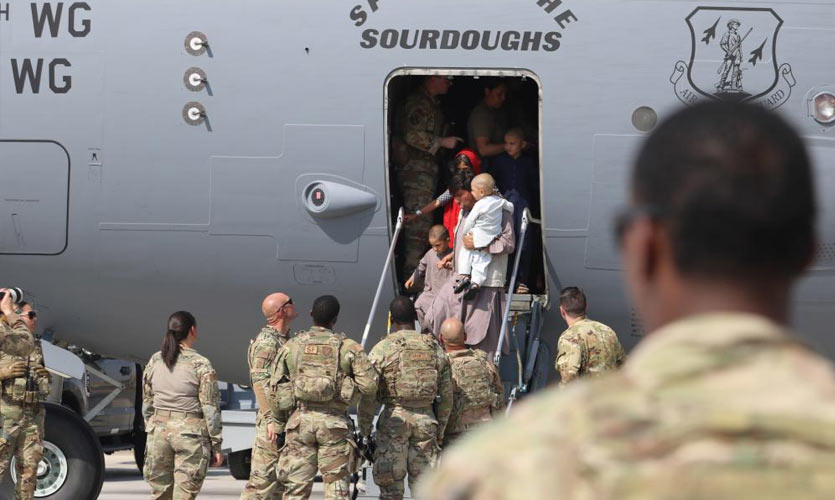Since the Taliban took over the capital city of Kabul on August 15 and the US-trained Afghan troops yielded to the Taliban, there has been chaos in the nation. People who remember the previous Taliban regime are eager to not be left behind, and have been spotted clamouring to board the planes leaving Kabul. Pakistan is reportedly seeing a refugee inflow already. In the aftermath of the US’ hasty withdrawal after the 20-year conflict, India is now experiencing a surge in the number of migrating refugees. Western countries are also expected to receive a high number of refugees.
US President Biden has considered the possibility of extending the August 31 deadline for removing all American troops from Afghanistan. Biden has, reportedly, assured that all evacuated Afghan allies will be provided with a home in the US after they have been screened and vetted at other bases.
The Week reported that amidst the chaos, the US will award up to 80,000 special immigrant visas to people who assist US forces on the ground. Some 30,000 Afghans are expected to move to the United States soon, with some temporary accommodations being provided at Fort Bliss in El Paso, Texas. As reported by the Guardian, Fort Bliss also houses tented camps for unaccompanied migrant children such as those arriving from Mexico without legal guardians.
The federal Department of Health and Human Services (HHS) has stated that it has space for up to 5,000 such unaccompanied children at Fort Bliss, and is currently housing 2,551 people at what the Biden administration calls an emergency intake site (EIS), where operations have been complicated by the coronavirus pandemic. Nearly 324 people will be settled through the Refugee Services of Texas offices in Houston, Dallas, Fort Worth, and Austin. The United States Defense Secretary Lloyd J. Austin III has ordered six commercial airlines to provide passenger jets to help with the evacuation of Americans and Afghan allies from Kabul. Civil Reserve Air Fleet Stage 1 has been activated by Austin to ferry passengers arriving at bases in the Middle East from Afghanistan, as explained by John F. Kirby, the Pentagon spokesperson, in his statement. The fleet was formed in 1952 after the Berlin Airlift.
According to the New York Times, 18 planes will be activated: four from United Airlines; three each from American Airlines, Atlas Air, Delta Air Lines, and Omni Air; and two from Hawaiian Airlines. In Kabul, where the security situation has been rapidly deteriorating, civilian planes cannot fly into or out of the city. Instead of using government planes to transport Afghans, commercial airline pilots and crews are tasked with arranging transportation for Afghans arriving at the US bases in Bahrain, Qatar, and the United Arab Emirates. Commercial airlines will put less strain on those bases that are currently crowded. The Biden administration is rushing to increase flights for Afghans terrified of Taliban reprisals. The airliners will augment military flights carrying Afghans to Germany, Italy, Spain, and other European stops, as per officials.
Biden, on August 23, stated that the military has evacuated 28,000 people from Kabul since August 14, after the Taliban seized control of the nation. He added that the military has enlarged the protective perimeter surrounding the airport, and that the military authorities might consider staying in the nation through August 31 in order to finish evacuations.
Taliban co-founder, Abdul Ghani Baradar is anticipated to play a significant role in discussions between the Taliban and Afghan government officials who were ousted by the terrorist organisation. Afghan sources involved with the capital’s negotiations said the Taliban have indicated that they will not make any pronouncements about their government unless the NATO pullout deadline of August 31 is met. Abdullah Abdullah, a top member in the deposed administration tweeted that on Saturday, he and ex-President Hamid Karzai met with the Taliban’s acting governor of Kabul, who told them that he would do everything necessary to ensure the city’s security.
Read more: Why Have Russia, China And Iran Decided To Let It Play Out With The Taliban?
The US is under pressure from the international community to welcome as many Afghan refugees as feasible on moral grounds. Several state governors and officials have issued statements offering assistance to Afghan refugees and welcoming them. However, other conservatives are concerned that allowing them in would cause a disaster. Even a state split on immigration has stated that it will assist thousands of refugees who are due to arrive. Several of the refugees, on their way to the United States, have assisted US forces in different capacities on ground, including administrative support and translation. The refugees are likely to be accommodated in big military complexes or comparable large facilities at first.
In Wisconsin, Governor Tony Evers suggested about 2,000 migrants may be relocated to Fort McCoy, a large military installation in the state’s southwestern corner that housed approximately 14,000 Cuban refugees in 1980.
The United States, on the other hand, has made no guarantees about how many civilians will be evacuated from Afghanistan. Sunil Varghese, policy director for the International Refugee Assistance Project told VOA that removing displaced Afghans, and enrolling them in the refugee programme, are two very different things.
As reported by ABC News, on August 16, President Biden issued a memo allocating $500 million for refugees, victims of conflict, and other persons at risk as a result of the situation in Afghanistan, including applicants for the Special Immigrant Visas. Apart from this, forty-six senators have demanded the creation of a humanitarian parole category to give women activists and leaders from Afghanistan entry to the United States.










